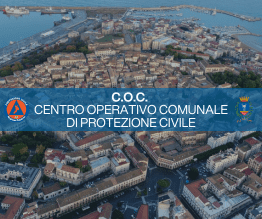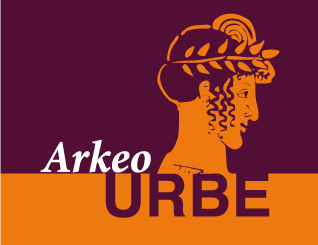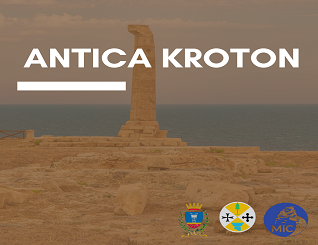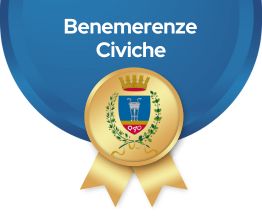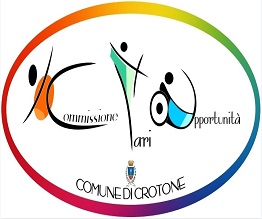Town - History and Monuments
- Panoramic view of Crotone
Crotone, [kro'tone] in IPA (International Phonetic Alphabet), Croto in Latin, Κρότωνin ancient greek, Κρότωναςin modern greek, Cutroni in Crotonian dialect, it is part of the Authority ofthe inter-regional basin of the Esaro River. As regards the southern side, however, is entirely surrounded by the protected marine area of Capo Rizzuto, which together with the promontory of Capo Colonna, encloses the city in a large basin and separate it from the Gulf of Squillace. The foundation of Crotone dates back to 718 b.C., like issigned by Eusebio in his "Cronicon" although other sources postpone it to 710 b.C., or during the time when the King Polidoro reigned, in 743 b.C. The city has been founded by the Acheis. The legend narrates that the name Crotone derives from "Kroton", child of Eaco, that died killed for error by his friend Eracle. The young man, to make up for to the finished error and to honor the friend that had entertained him, made to bury Kroton with solemn ceremony on the banks of the stream Esaro and then he made to rise the city to which he gave the name of his friend, near his grave. According to a legend, the oracle of Apollo to Delfi ordered to Myskellos of Rhype to found a new city in the inclusive territory among Capo Lacinio and Punta Alice. After having crossed the sea and explored those earths, Myskellos thought that it would have been better to stay to Sybaris, already florid and pleasant, rather than to face the dangers and the difficulties in the foundation of a new city. The angry god, ordered him to respect the response of the oracle. According to Ovidio, it would have been instead Eracle to order to Myskellos to approach on the shores of the river Esaro. Another tradition bring back up the name of the city to the hero Crotone, brother of Alcinoo, the King of the Feacis. After a pacific initial coexistence, among the Magnogrecian cities, towardhalves the V b.C. it began the discords, that reproduced to distance the clashbetween Athens and Sparta. In 560 b.C. Kroton and Locri began a decennial war, that its concluded with the battle of the Feast, won by the Locresis, sustained by Sparta.

- View of the city bathed by the Ionian
The city was famous for its healthy climate, for the beauty of its women, for the fertile countries and for the physical strength of its men, among which the pluri-Olympic Milone is remembered, so much that Kroton overcame every other Greek city in the number of winners in the Olympic Games: a proverb said "the last of the Crotonians, the first one of the Greek". A legend narrates that Milone, departed from the ionic polis, bringing a calf and came to Olimpia with a bull on the shoulders, arousing wonder and clamor, and winning therefore numerous competitions. The coast introduced a very different profile than the current, in the line of sea between the ancient Enotria (Cirò is also present in contemporary epoch, the village of the nectar of the gods, the wine that was given in prize to the winners of the Athenian Olympic games) and the actual Le Castella. To few miles from the shore, imposing for their beauty, the visible islands from the coast, now swallowed by the sea, they sprouted from the waters of the Ionian. The islands directed, also the most inexperienced navigators. Melissea, of forehead the coast among Tower Melissa and Marina of Strongoli, of which rests exist that theunderwater fishermen know well, that it was characterized from a submerged marmoreal balcony, that probably encircled the island. Tyris, an afloat grove lived by fishermen Brutii (a native people), was situated between Turret of Crucoli and Point Alice (Cirò Marina). Eranusa was situated before the actual site of Le Castella, where the submerged archaeological rests are situated: apavement of flooring of an ancient road, a dock with stairways chiseled in therock, cisterns, an ancient lighthouse.
The island of Ogigia, called also Calipso, was the most famous island, also described by Humerus as a real terrestrial heaven. The island in fact, lived by the nymph Calipso as Humerus narrates in the odyssey, entertained for eight years Ulisse during his trip back from Troy. In the ancient maps of the Kingdom in Naples, there is another island of similar dimensions, suitable with the name of Dioscoron or the island of the Dioscuris.

- Aerial mapping of the port of Crotone
Kroton was also famous for his physicians among which we remember Democede (a friend of Pitagora) and Alcmeone, which introduced the experimentation transforming the medicine, that until then it was contaminated from magic and superstition, in a science. Pitagora, been born to Samo in 572 b.C., moves to the city of Kroton, near the friend Democede. He created a school of the to know, of science, mathematics, music, seeing that Pitagora had brought with itself the to know and numerous oriental manuscripts, coming from Tibet, and written Jewish of the King Salomone [Clavicles].
After the arrival of Pitagora, Kroton moved against Sibari, until then his allied. Infact, a habit of the crotoniatis was that to go to the thermal baths to Sibaris, or to assist to shows, or to frequent prostitutes. In 512 b.C., three noble crotonian were slaughtered and their bodies were thrown to the wolves whocrowded around the swamps Sibaris, because one of them were fallen in love of a beautiful vestal by the blue eyes, that hehad tried to abduct. This fact, assistant to the centenary rivalry among the two due cities to commercial motives, political and of different religious affiliation, convinced the crotoniatis to make war on Sibaris. In 510 b.C. a battle took place near the river Nika (in Cariati), from where crotonians pursued and destroyed Sibarite forces in a final battle at the ford of the river Trionto (near Mirto Crosia). According to thelegendary tradition 100.000 crotonians fought, led by the Olympic athlete Milone, against the Sybaritic which were the triple more numerous. The victoryar rise to Kroton, despite the numerical inferiority, since the Sybaritic for the battle used horses taught to perform foot steps of dance in the shows to the sound of the flutes. Crotonian, in the battle of Nika, began to play the flutes, performing the same melody with which the horses had been taught to dance with the result that the avant-garde of the Sybarite troops were immediately unsaddled. And afterseventy days of lootings, according to a suggestion furnished by Pitagora, the course of the river Crati was diverted, and its flow made to disappear Sibari forever.
Pitagora with his disciples, conquered the political power of the city: in few years the pitagoricis governments were consolidated in a lot of polees of Great Greece, constituting a sort of confederation amongcity-state with capital Kroton, as it results to be from numerous coins coinedbetween 480 b.C. and 450 b.C.. Kroton, comes at the most of its political and cultural hegemony, was crushed by aseries of social conflicts that flowed in the bloody revolt led by Cilone during which many Pythagorean were slaughtered and and even Pythagoras himself had to flee from Kroton and repaired in Metaponto. At the same time the other national governments fell and there were similar massacres and persecutions of the Pythagoreans in all poleis of Italy. After the downfall of the Pythagorean government, Kroton experienced a periodof decline. It constituted, with Metaponto and Caulonia, the Italian League to defend oneself from the attacks of the Lucanian populations. In 383 b.C. the Federation was defeated by Dionysius I of Syracuse, in a bloody battle.
The Romans conquered Kroton in 277 b.C., led by the consul Cornelius Rufinus. During the Second Punic War Hannibal kept his winter quarters here, forthree years and from there sailed to Africa in 203 b.C.. In 194 b.C. a Roman colony was deducted. The city resources back into the Byzantine period, when it was center of a garrison even though it decayed during the Roman empire. In 1284 the city was granted from the Angioini to the Ruffos of Catanzaro. In 1434 to the death of Don Niccolò, son of Antonello and last marquis of Crotone, his daughter Giovannella was in succession of the title, murdered in her home a year later. The next title passed to her sister Henriette, that got married in second wedding the noble Spanish Mr. Anthony Centelles, Count of Collesano and Prince of Santa Severina, without having heirs.
In the XVI century, the king of Spain Charles V granted to the city ample privileges and and did enhance the port. In 1541, the viceroy Mr. Pedro Toledo made restore and to streng then the preexisting castle, today known as "Charles' V Castle". In the XVI century the city was called "Cotrone". In 1928 the city changed its name from Cotrone to Crotone. Its port, which strategically fills the distances between the neighboring ports of Taranto and Messina, encourages every exchange activities and becomes a drivingforce for the agricultural economy and industrial activities. The industrial installation has seen the city protagonist in the period between the two world wars, also thanks to its proximity to the hydroelectric plant of Calusia, near Cotronei. The population of Crotone doubles during the thirties, thin to reach the 60.000 today's inhabitants. At the end of the years '80 the principal industries, the Pertusola Sud and the Montedison have suffered adeep crisis, which affected the entire city. At the end of the years '90, the industrial history of Crotone finished and the city falls in a deep financial crisis that forced it to redraw its ownpartner-economic dimension. The city today is the fifth of Calabria with regard to the number of inhabitants, and plays the role of the most significant urban center of the Ionian region. The territory of Crotone, away from that worker experience of last century, it is proposing in the agribusiness and tourism.

- Cathedral - Main Facade
City of the good food, city of sea, city of history, city of the culture, Crotone offers its visitors a vast cultural heritage richer in two thousand years, moving from the archeology of Ancient Greece to the fortifications of the Aragonese dynasty, a medieval towncenter, where precious noble houses and ancient places of worship are located:
The Cathedral: the original construction of the Cathedral should goback to the IX century. Initially it was dedicated to St. Dionysius, later, around 1462-1463 to Maria SS. Assunta into heaven. During the centuries, the church was subject to various restoration, although in the XVI century the bishop A. Lucifero worked its complete reconstruction, using materials removed from the ancient temple of Hera Lacinia. The interior of the church has three naves divided by pillars. The Chapel of the Madonna di Capo Colonna, in the Cathedral, it is worthy of noteand contains the icon of the Madonna di Capo Colonna, also called the "Black Madonna" for the dark complexion with which it is painted herskin. The lady, to whom many miracles are attributed, is celebrated in Crotone in May, Marian month par excellence and dates back to centuries X-XI. The chapel instead, consecrated in 1911, was designed by Farinelli and frescoed by Severini. It is richly decorated with plasters and frescos, realized in 1904 by Phillip De Falco and by Boschetto, which tell of the discovery of the sacred image and miraculous events due to the intercession of the Black Madonna. Noteworthy is also the baptismal font placed in the Epiphany Chapel, dating from the century XIII.
St. Salvator's Church: the church already existed in 1500 and is one of the historic churches of Crotone. In 1783 it was damaged by the earthquake, rebuilt ex-novo and it brought to the actual greatness. Before this date, the culmination of the facade had the characteristic undulating present in other churches of the viceregnale period.
- Church of the Immaculate Conception - Nave
The Church of the Immaculate Conception: its constructiondates back to 1554, when it was formed by a small temple with underlying crypt. In 1682 the church dedicated to the immaculate was built on the old oratory, on initiative of the Congregation of the Plebeians, formed by artisans and bourgeois, so called because it stand out from the Congregation of the Nobles, who was based in the church of St. Joseph. A new and elegant church was erected in 1758, subsequently enlarged by Girolamo Cariati and consecrated by Monsignor Capocchiani. The consecration took place in the 1777. The facade of the Church, of neoclassic formulation, dates back to about 1830, and it is, therefore, subsequent to the date of its construction. The crypt towhich is accessed through a wooden doorof the seventeenth century, is worthy ofnote. It is constituted by two arcs that introduce in the actual chapel, with stone cornicing local tufa and terracotta floor painted of red, all original ofthe '500. The environment is constituted by a door and slabs in glass and iron that eclose, lying on three steps, 490 skulls of the monks of the Brotherhood. A sculpture wooden representing the crucified Christ, is conserved on the upper body to the right side, built between 1630-1640. It is one of the fewin the world where the crucified Christ is represented with open eyes, just before expiring. It was originally in the chapel of the convent-hospital in which the Friars Fatebenefratelli operated. With the suppression of the convent, the crucifix Christ moved to the church of S. Joseph, in the noble chapel of the Zurlo family, in which it was preserved under bad conditions being subjected to the action of rainwater. In fact, on May 3, 1956, during a procession, the head its detached causing the shattering of the crystal in the left eye, still visible. The crucifix moved then to the Church of the Immaculate Conception and opportunely restored.
St. Maria in Prothospatariis' Church: dating from the century XV, therefore it is one of the oldest in Crotone. In fact it is witnessed its existence as a parish within the walls in 1525. Royal's assignment, it was probably founded by the noble family "Prothospatariis", of Greek origin, so that they also had the patronage. According to other scholars, however, the name alludes to Prenotari, or to a set of notable people who were patrons of the place in this church. Until 1777 it had two altars: onededicated to St. Aloysius Gonzaga, the other in St. Gaetano. The church, with a nave, has an elongated body with a semicircular apse. The main facade has a portal of tufastone surmounted by a solid line entablature decorated with floral motifs and supported by side brackets. Above there is a stained glass rose window.

- St. Clare's Church - Antique wardrobe
St. Clare's Church: the church was part of the monastery of St. Clare. The original structure dates back to the end of 1300, while the current building presents the contributions of the 1700s and in the early 1800s. The church, in the Baroque style, has been consecrate in 1774, as it appears on a marble plaque placed at the entrance. The plaque, in Latin, tells the embellishment, the reconstruction, the treasures offered in the second half of 1700 by the abbess M. Angelica Galluccio. The convent housed the daughters of crotonians noble families: many coats of arms (Galluccio, Ventura, Sculco, Lucifer) affixed to every gift offered to the monastery symbolize this fact. St. Clare's Church is the jewel of theold town centre, especially for the rich heritage that it holds within it, including a cabinet that contains a pipe organ, built in 1753 by Tommasio De Martino, orginating of the royal chapel in Naples and wooden shutters of the choir, which was entrusted with the task of guarding the cloistered Sisters adorers of St. Clare.
The ex - Town Hall: the current House of Culture, was originally center of the Convent of St. John of God, governed by the religious order of the "Brothers Hospital" andtook office in 1667. Annexed to the Hospital of the city, also called by thepeople "Fatebenefratelli", it was a church dedicated to Our Lady of the Pity or Our Lady of Sorrows. The hospital came to accommodate about 600 people poor and sick, also foreign. In 1777 the number of monks of the monastery fell to 3 and, consequently, also for lack of funds, the monastery was suppressed atthe end of the century. The hospital remained active and became public with the name of S. John of God. In 1883, the building was converted to house the Town Hall, while the church was converted in to stores and the hospital was moved. Later it was also home to primary schools and some offices of the ASL. In the second half of the 800 the building was much altered. The old bell tower was transformed into a clock tower and the facade was given an nineteenth century imprint. At the central balcony in 1906 two plaques have been put: one to memory of the magistrates of the Republic of Naples died as a result of the Sanfedista Restoration, the other to commemorate the expedition of the Bandiera Brothers, landed in Crotone, in 1844.
- Church of St. Joseph - Facade
St. Joseph's Church: the main body of the church probably dates from the XVI, while the noble chapels were added in 1719, by the will of the priest Onofrio Sandria as it brings an inscription stone on the portal. It was restored in1744 after a massive earthquake and it was consecrated in 1756. It is believed that its construction was ordered by some noble families gathered in Crotone Brotherhood of the Seven Sorrows of the Virgin Mary or the Our Lady Sorrows, whothen offered it as a gift to the city. The interior consists of a nave with thesides, 4 chapels built by the following noble families: Galluccio, Lucifero,Sculco, Zurlo (the latter belonged to the family Ayerbis of Aragon). The high altar has been, instead, donated by the Berlingeri family. The facade isadorned with a beautiful portal in late Baroque style, in sandstone.
Some monuments are located in different areas of Crotone and represent characters or important historical moments in the history of the city:
Bandiera Brothers Memorial
War Memorial 1915-1918
Carlo Turano Memorial
Raffaele Lucente Memorial
Armando Lucifero Memorial
The Legionnaire










